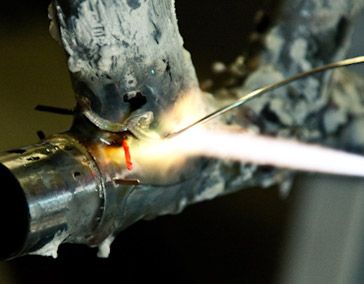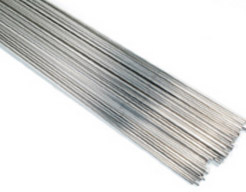Silver brazing, frequently called “hard soldering” or “silver soldering,” is a low-temperature brazing process with rods having melting points ranging from 1145 to 1650ºF (618 to 899ºC).
This is considerably lower than that of the copper alloy brazing filler metals.
The strength of a joint made by this process is dependent on a thin film of silver brazing filler metal.
Brazing vs. Soldering
Silver solder is commonly used in jewelry, copper and brass. It is weaker than a silver braze.
Brazing is the same as soldering, except brazing occurs at higher temperatures.
Basics
- Occurs at 1200 degrees Fahrenheit
- 5-50% of metal is silver, rest is usually copper and zinc
- Expensive at $50 or more an once
- Capillary attraction in small cracks
Silver brazing filler metals are composed of silver with varying percentages of copper, nickel, tin, and zinc.
They are used for joining all ferrous and non-ferrous metals except aluminum, magnesium, and other metals which have too low a melting point.
WARNING
Cadmium oxide fumes formed by heating and melting of silver brazing alloys are highly toxic. To prevent injury to personnel, personal protective equipment must be worn and adequate ventilation provided.
It is essential that the joints be free of oxides, scale, grease, dirt, or other foreign matter. Surfaces other than cadmium plating can be easily cleaned mechanically by wire brushing or an abrasive cloth; chemically by acid pickling or other means.
Extreme care must be used to grind all cadmium surfaces to the base metals since cadmium oxide fumes formed by heating and melting of silver brazing alloys are highly toxic.
Silver Brazing

Flux
Flux is generally required. The melting point of the flux must be lower than the melting point of the silver brazing filler metal. This will keep the base metal clean and properly flux the molten metal. A satisfactory flux should be applied by means of a brush to the parts to be joined and also to the silver brazing filler metal rod.
When silver brazing by the oxyacetylene process, a strongly reducing flame is desirable. The outer envelope of the f1ame, not the inner cone, should be applied to the work. The cone of the flame is too hot for this purpose. Joint clearances should be between 0.002 and 0.005 in. (0.051 to 0.127 mm) for best filler metal distribution. A thin film of filler metal in a joint is stronger and more effective, and a fillet build up around the joint will increase its strength.
The base metal should be heated until the flux starts to melt along the line of the joint. The filler metal is not subjected to the flame, but is applied to the heated area of the base metal just long enough to flow the filler metal completely into the joint. If one of the parts to be joined is heavier than the other, the heavier part should receive the most heat. Also, parts having high heat conductivity should receive more heat.
As an alternative, you can try newer technology that uses a fluxless brazing rod such as HTS 2000 Brazing Rods.
Silver Brazing Rods

Process
Silver brazing uses the same basic methods of other brazing methods including fit for proper capillary action, cleaning of base metals, the use of flux, heat and post braze cleaning.
When heating the assembly, heat uniformly, with greater heat on the thicker metal section If one metal has better heat conductivity than the other, apply more heat to the better heat conductor.
Note that filler metals flow to the higher heat source.